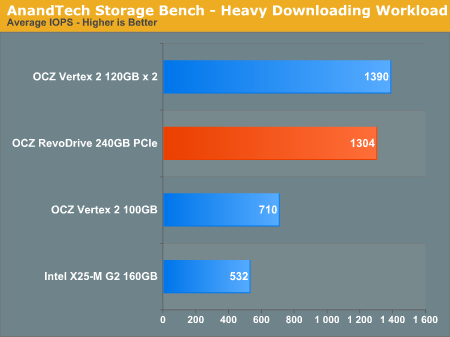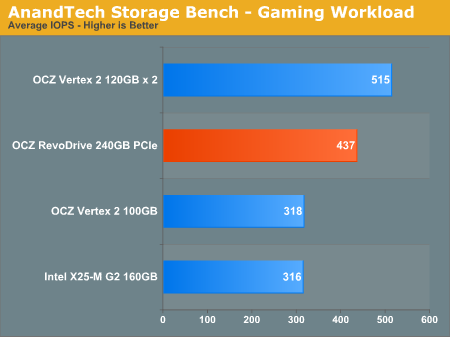OCZ's RevoDrive Preview: An Affordable PCIe SSD
by Anand Lal Shimpi on June 25, 2010 2:15 AM ESTAnandTech Storage Bench
The first in our benchmark suite is a light usage case. The Windows 7 system is loaded with Firefox, Office 2007 and Adobe Reader among other applications. With Firefox we browse web pages like Facebook, AnandTech, Digg and other sites. Outlook is also running and we use it to check emails, create and send a message with a PDF attachment. Adobe Reader is used to view some PDFs. Excel 2007 is used to create a spreadsheet, graphs and save the document. The same goes for Word 2007. We open and step through a presentation in PowerPoint 2007 received as an email attachment before saving it to the desktop. Finally we watch a bit of a Firefly episode in Windows Media Player 11.
There’s some level of multitasking going on here but it’s not unreasonable by any means. Generally the application tasks proceed linearly, with the exception of things like web browsing which may happen in between one of the other tasks.
The recording is played back on all of our drives here today. Remember that we’re isolating disk performance, all we’re doing is playing back every single disk access that happened in that ~5 minute period of usage. The light workload is composed of 37,501 reads and 20,268 writes. Over 30% of the IOs are 4KB, 11% are 16KB, 22% are 32KB and approximately 13% are 64KB in size. Less than 30% of the operations are absolutely sequential in nature. Average queue depth is 6.09 IOs.
The performance results are reported in average I/O Operations per Second (IOPS):

The OCZ RevoDrive does very well in our light usage case, but it does echo what we saw in the PCMark results. The performance benefit here is 27% however that’s purely I/O. Taken in the context of the real world with CPU and other bottlenecks you’re probably looking at a 7 - 15% performance advantage. Thankfully the RevoDrive doesn’t come with a high premium, making the added performance very cost effective.
If there’s a light usage case there’s bound to be a heavy one. In this test we have Microsoft Security Essentials running in the background with real time virus scanning enabled. We also perform a quick scan in the middle of the test. Firefox, Outlook, Excel, Word and Powerpoint are all used the same as they were in the light test. We add Photoshop CS4 to the mix, opening a bunch of 12MP images, editing them, then saving them as highly compressed JPGs for web publishing. Windows 7’s picture viewer is used to view a bunch of pictures on the hard drive. We use 7-zip to create and extract .7z archives. Downloading is also prominently featured in our heavy test; we download large files from the Internet during portions of the benchmark, as well as use uTorrent to grab a couple of torrents. Some of the applications in use are installed during the benchmark, Windows updates are also installed. Towards the end of the test we launch World of Warcraft, play for a few minutes, then delete the folder. This test also takes into account all of the disk accesses that happen while the OS is booting.
The benchmark is 22 minutes long and it consists of 128,895 read operations and 72,411 write operations. Roughly 44% of all IOs were sequential. Approximately 30% of all accesses were 4KB in size, 12% were 16KB in size, 14% were 32KB and 20% were 64KB. Average queue depth was 3.59.

Our heavy test shows the RevoDrive nearly doubles the performance of a single OCZ Vertex 2.
The gaming workload is made up of 75,206 read operations and only 4,592 write operations. Only 20% of the accesses are 4KB in size, nearly 40% are 64KB and 20% are 32KB. A whopping 69% of the IOs are sequential, meaning this is predominantly a sequential read benchmark. The average queue depth is 7.76 IOs.

Our gaming workload also improves a bit as well. This thing is quick. A pair of Vertex 2s in RAID are still faster thanks to Intel's controller.










62 Comments
View All Comments
cgaspar - Monday, June 28, 2010 - link
If you re-flash the card with SIL3124 non-RAID BIOS, it should look just like 2 SSDs, and TRIM should work.oshato - Monday, June 28, 2010 - link
I too would like to see the pass through configuration ( non-raided ) tested for TRIM support and db IOPS #s. Curious how feasible this would be for a zfs ZIL in pass through mode.marraco - Monday, June 28, 2010 - link
I'm worried about video performance in single and dual setups with this SSD working.marraco - Monday, June 28, 2010 - link
What about boot time?the RAID controller should increase the POST time, and that frequently destroys the boot advantage of SSD under RAID.
javaman3 - Tuesday, June 29, 2010 - link
Does anyone know if this card will work in OSX? I would like to know specifically if it will run in an Xserve.clarkn0va - Tuesday, June 29, 2010 - link
I think there's another, if less common need for this: places where you lack drive bays or SATA ports. Some examples:-SFF servers, most of which accommodate only 1 3.5" drive or 2 2.5" drives. Would be nice to have a little 1U Atom board running a small NAS/application server and cram a little more storage in. I have a mini-ITX server doing nfs, torrents, voip, monitoring, etc and would love to move it to a small rack, but until now couldn't justify the loss of drive space. With the OS and applications running on a RevoDrive, bulk data can live on a pair of 2.5" drives and we're all good.
-Enterprise servers. I'm shopping out a terminal server at work and the cost of purchasing drives with your new server is laughable. The highest-end SLC drives from Intel and OCZ cost less than the OEM-branded grab-bag the server vendors are offering. I would much rather put my own drives in there, thanks, and cruising ebay for compatible drive caddies just feels wrong. pcie slots, on the other hand, come with the server without paying some stupid OEM storage premium.
Now the questions.
1. The article says you configure your own RAID-0. Will the utility also let me configure it as RAID-1 if I want?
2. Anybody know what it's like to try to boot Linux from one of these devices?
cosplay - Thursday, July 8, 2010 - link
Nice reading, thanks for another SSD review.btw, on Installation and Early Issues you have a typo:
I headed into the Silicon Image BIOS, asked to recreate the array, specified the entire 233GB
clarkn0va - Friday, July 9, 2010 - link
What are the lengths of these 2 cards? I'd really like to put one in a case that only takes half-length cards.LightningCrashTSI - Wednesday, July 14, 2010 - link
FTA:"The OCZ RevoDrive will offer lower CPU utilization than an on-board software based RAID solution thanks to its Silicon Image RAID controller,"The Silicon Image RAID controller is a software-based RAID controller as well.
Conradical314 - Thursday, August 12, 2010 - link
The important question is, which Firefly episode?Was at first very disappointed to hear about this drive, but thanks to your review I see it would only have made a small effect on actual usage, so I don't need to regret recently getting OCZ Vertex II 120GB too much.